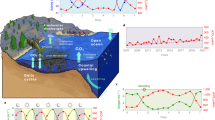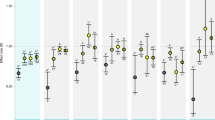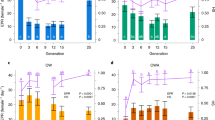Abstract
Global stressors, such as ocean acidification, constitute a rapidly emerging and significant problem for marine organisms, ecosystem functioning and services. The coastal ecosystems of the Humboldt Current System (HCS) off Chile harbour a broad physical–chemical latitudinal and temporal gradient with considerable patchiness in local oceanographic conditions. This heterogeneity may, in turn, modulate the specific tolerances of organisms to climate stress in species with populations distributed along this environmental gradient. Negative response ratios are observed in species models (mussels, gastropods and planktonic copepods) exposed to changes in the partial pressure of CO2 () far from the average and extreme levels experienced in their native habitats. This variability in response between populations reveals the potential role of local adaptation and/or adaptive phenotypic plasticity in increasing resilience of species to environmental change. The growing use of standard ocean acidification scenarios and treatment levels in experimental protocols brings with it a danger that inter-population differences are confounded by the varying environmental conditions naturally experienced by different populations. Here, we propose the use of a simple index taking into account the natural variability, for a better interpretation of the potential consequences of ocean acidification on species inhabiting variable coastal ecosystems. Using scenarios that take into account the natural variability will allow understanding of the limits to plasticity across organismal traits, populations and species.
This is a preview of subscription content, access via your institution
Access options
Access Nature and 54 other Nature Portfolio journals
Get Nature+, our best-value online-access subscription
$29.99 / 30 days
cancel any time
Subscribe to this journal
Receive 12 digital issues and online access to articles
$119.00 per year
only $9.92 per issue
Buy this article
- Purchase on Springer Link
- Instant access to full article PDF
Prices may be subject to local taxes which are calculated during checkout



Similar content being viewed by others
References
Caldeira, K. & Wickett, M. Ocean model predictions of chemistry changes from carbon dioxide emissions to the atmosphere and ocean. J. Geophys. Res. 110, C09S04 (2005).
Orr, J. C. et al. Anthropogenic ocean acidification over the twenty-first century and its impact on calcifying organisms. Nature 437, 681–686 (2005).
Zalasiewicz, J., Williams, M., Haywood, A. & Ellis, M. The Anthropocene: a new epoch of geological time? Phil. Trans. R. Soc. A. 369, 835–841 (2011).
Gattuso, & J. P. et al. Contrasting futures for ocean and society from different anthropogenic CO2 emissions scenarios. Science 349, 49–55 (2015).
Magnan, A. K. et al. Implications of the Paris agreement for the ocean. Nat. Clim. Change 6, 732–735 (2016).
Bowman, H. I. Applying organized scepticism to ocean acidification research. ICES J. Mar. Sci. 73, 529–536 (2016).
Doney, S. C. The growing human footprint on coastal and open-ocean syndrome? Understanding anthropogenic impacts on seawater pH. Science 328, 1512–1516 (2010).
Fabry, V. J., Seibel, B. A., Feely, R. A. & Orr, J. C. Impacts of ocean acidification on marine fauna and ecosystem processes. ICES J. Mar. Sci. 65, 414–432 (2008).
Cornwall, C. E. & Hurd, C. L. Experimental design in ocean acidification research: problems and solutions. ICES J. Mar. Sci. 73, 572–581 (2016).
Barry, J. P., Hall-Spencer, J. M. & Tyrrell, T. in Guide to Best Practices for Ocean Acidification Research and Data Reporting (eds Riebesell, U., Fabry, V. J., Hansson, L. & Gattuso, J. P.) 53–66 (Publications Office of the European Union, 2010).
Kroeker, K., Kordas, R., Crim, R. & Singh, G. Meta-analysis reveals negative yet variable effects of ocean acidification on marine organisms. Ecol. Lett. 13, 1419–1434 (2010).
Waldbusser, G. G. & Salisbury, J. E. Ocean acidification in the coastal zone from an organism’s perspective: multiple system parameters, frequency domains, and hábitats. Annu. Rev. Mar. Sci. 6, 221–247 (2014).
Feely, R. A., Sabine, C. L., Hernández-Ayon, J. M, Ianson, D. & Hales, B. Evidence for upwelling of corrosive “acidified” water onto the continental shelf. Science 320, 1490–1492 (2008).
Salisbury, J., Green, M., Hunt, C. W. & Campbell, J. Coastal acidification by rivers: a threat to shellfish? Eos 89, 513–528 (2008).
Cai, W.-J. et al. Acidification of subsurface coastal waters enhanced by eutrophication. Nat. Geosci. 4, 766–770 (2011).
Hoffman, G. E. et al. High-frequency dynamics of ocean pH: a multi-ecosystem comparison. PLoS ONE 6, e28983 (2011).
Reum, J. C. P. et al. Interpretation and design of ocean acidification experiments in upwelling systems in the context of carbonate chemistry co-variation with temperature and oxygen. ICES J. Mar. Sci. 73, 582–595 (2016).
Duarte, C. M. et al. Is ocean acidification an openocean syndrome? Understanding anthropogenic impacts on seawater pH. Estuaries Coasts 36, 221–236 (2013).
Dorey, N., Lancon, P., Thorndyke, M. & Dupont, S. Assessing physiological tipping point for sea urchin larvae exposed to a broad range of pH. Glob. Change Biol. 19, 3355–3367 (2013).
Ventura, A., Schulz, S & Dupont, S. Maintained larval growth in mussel larvae exposed to acidified under-saturated seawater. Sci. Rep. 6, 23728 (2016).
Thor, P. & Dupont, S. Transgenerational effects alleviate severe fecundity loss during ocean acidification in a ubiquitous planktonic copepod. Glob. Change Biol. 21, 2261–2271 (2015).
Kapsenberg, L., Kelley, A. L., Shaw, E. C., Martz, T. R. & Hofmann, G. E. Seasonal pH variability in near-shore Antarctica in the present and future. Sci. Rep. 5, 9638 (2015).
Kapsenberg, L. & Hofmann, G. E. Regional to local influences on daily to inter-annual pH variability in the northern Channel Islands, California, USA. Limnol. Oceanogr. 61, 953–968 (2016).
McElhany, P. & Busch, D. S. Appropriate pCO2 treatments in ocean acidification experiments. Mar. Biol. 160, 1807–1812 (2012).
Angilletta, M. J. Thermal Adaptation: A Theoretical and Empirical Synthesis (Oxford Univ. Press, 2009).
Pérez, C. A. et al. Influence of climate and land use in carbon biogeochemistry in lower reaches of rivers in central–southern Chile: implications for the carbonate system in river-influenced rockyshore environments. J. Geophys. Res.: Biogeosci. 120, 673–692 (2015).
Calosi, P. et al. Adaptation and acclimatization to ocean acidification in marine ectotherms: an in situ transplant experiment with polychaetes at a shallow CO2 vent system. Phil. Trans. R. Soc. B 368, 20120444 (2013).
Bednarsêk, N. et al. Limacina helicina shell dissolution as an indicator of declining habitat suitability owing to ocean acidification in the California Current Ecosystem. Proc. R. Soc. B 281, 20140123 (2014).
Lardies, M. A. et al. Differential response to ocean acidification in physiological traits of Concholepas concholepas populations. J. Sea Res. 90, 127–134 (2014).
Vargas, C. A. et al. CO2-driven ocean acidification disrupts the filter feeding behavior in Chilean gastropod and bivalve species from different geographic localities. Estuaries Coasts 38, 1163–1177 (2015).
Duarte, C. et al. Intraspecific variability in the response of the edible mussel Mytilus chilensis (Hupe) to ocean acidification. Estuaries Coasts 38, 590–598 (2015).
Hoffman, A. A. & Sgrò, C. M. Climate change and evolutionary adaptation. Nature 470, 479–485 (2011).
Wernberg, T. et al. An extreme climatic event alters marine ecosystem structure in a global biodiversity hotspot. Nat. Clim. Change 3, 78–82 (2013).
Applebaum, S. L., Pan, T.-C. F., Hedgecock, D. & Manahan, D. T. Separating the nature and nurture of the allocation of energy in response to global change. Integr. Comp. Biol. 54, 284–295 (2014).
Boyd, P. W. et al. Biological responses to environmental heterogeneity under future ocean conditions. Glob. Change Biol. 22, 2633–2650 (2016).
Beaman J. E., White, C. R. & Seebacher, F. Evolution of plasticity: mechanistic link between development and reversible acclimation. TREE 31, 237–249 (2016).
Bordeau, P. E. et al. What can aquatic gastropods tell us about phenotypic plasticity? A review and meta-analysis. Heredity 115, 312–321 (2015).
Thiel, M. et al. The Humboldt Current System of northern and central Chile: oceanographic processes, ecological interactions and socioeconomic feedback. Oceanogr. Mar. Biol. 45, 195–344 (2007).
Torres, R. et al. Air–sea CO2 fluxes along the coast of Chile: from CO2 outgassing in central northern upwelling waters to CO2 uptake in southern Patagonian fjords. J. Geophys. Res. 116, C09006 (2011).
Mayol, E., Ruiz-Halpern, S., Duarte, C. M., Castilla, J. C. & Pelegrí, J. L. Coupled CO2 and O2-driven compromisos to marine life in summer along the Chilean sector of the Humboldt Current System. Biogeosciences 9, 1183–1194 (2012).
Vargas et al. Riverine and corrosive upwelling waters influences on the carbonate system in the coastal upwelling area off central Chile: implications for coastal acidification events. J. Geophys. Res.: Biogeosci. 121, 1468–1483 (2016).
Torres, R. et al. Evaluation of a semi-automatic system for long-term seawater carbonate chemistry manipulation. Rev. Chil. Hist. Nat. 86, 443–451 (2013).
Aguilera, V. A., Vargas, C. A., Lardies, M. A. & Poupin, M. J. Adaptive variability to low-pH river discharges in Acartia tonsa and stress responses to high p CO 2 . Mar. Ecol. 37, 215–226 (2016).
Manríquez, P. H. et al. Effects of ocean acidification on larval development and early post-hatching traits in Concholepas concholepas (loco). Mar. Ecol. Prog. Ser. 514, 87–103 (2014).
Yang, Y., Hansson, L. & Gattuso, J.-P. Data compilation on the biological response to ocean acidification: an update. Earth Syst. Sci. Data 8, 79–87 (2016).
Acknowledgements
This work was supported by the Millennium Nucleus Center for the Study of Multiple-Drivers on Marine Socio-Ecological Systems (MUSELS) funded by MINECON NC120086 and the Millennium Institute of Oceanography (IMO) funded by MINECON IC120019. Previous and additional support from grants FONDECYT 1130254, 1060938, 1140938, 11400092 and 11130052 (RELOAD) is also acknowledged. We acknowledge L. Saavedra for data sharing through grant FONDECYT 3150392. S.D. is funded by the Centre for Marine Evolutionary Biology (CeMEB; http://www.cemeb.science.gu.se/) and supported by a Linnaeus grant from the Swedish Research Councils VR and Formas.
Author information
Authors and Affiliations
Contributions
All authors provided input into data availability and preliminary discussions. C.A.V. led the drafting of the text with main contributions in the same order from S.D., B.R.B., S.W., N.A.L., M.A.L., C.D., P.H.M. and V.M.A. C.A.V. carried out data analysis and the main structure of the study.
Corresponding author
Ethics declarations
Competing interests
The authors declare no competing financial interests.
Supplementary information
Supplementary Information
Supplementary Figures 1,2, Supplementary Table 1. (PDF 2380 kb)
Rights and permissions
About this article
Cite this article
Vargas, C., Lagos, N., Lardies, M. et al. Species-specific responses to ocean acidification should account for local adaptation and adaptive plasticity. Nat Ecol Evol 1, 0084 (2017). https://doi.org/10.1038/s41559-017-0084
Received:
Accepted:
Published:
DOI: https://doi.org/10.1038/s41559-017-0084
This article is cited by
-
Hidden impacts of ocean warming and acidification on biological responses of marine animals revealed through meta-analysis
Nature Communications (2024)
-
Short-term acidification promotes diverse iron acquisition and conservation mechanisms in upwelling-associated phytoplankton
Nature Communications (2023)
-
Epigenetic plasticity enables copepods to cope with ocean acidification
Nature Climate Change (2022)
-
The coral reef-dwelling Peneroplis spp. shows calcification recovery to ocean acidification conditions
Scientific Reports (2022)
-
Direct and latent effects of ocean acidification on the transition of a sea urchin from planktonic larva to benthic juvenile
Scientific Reports (2022)



